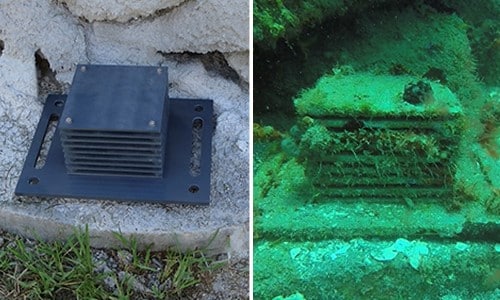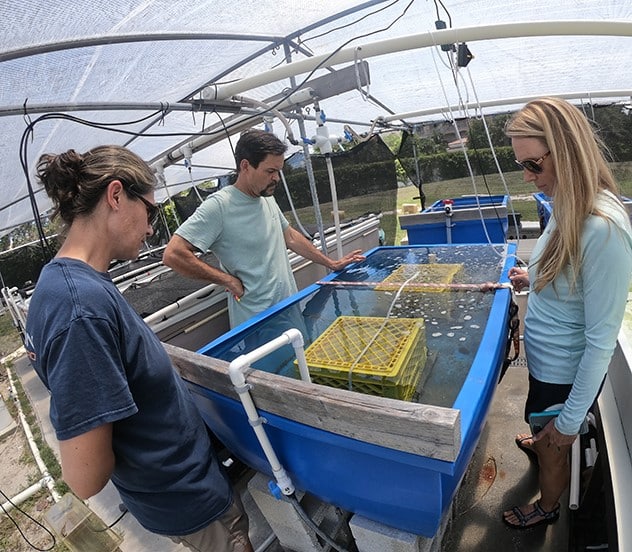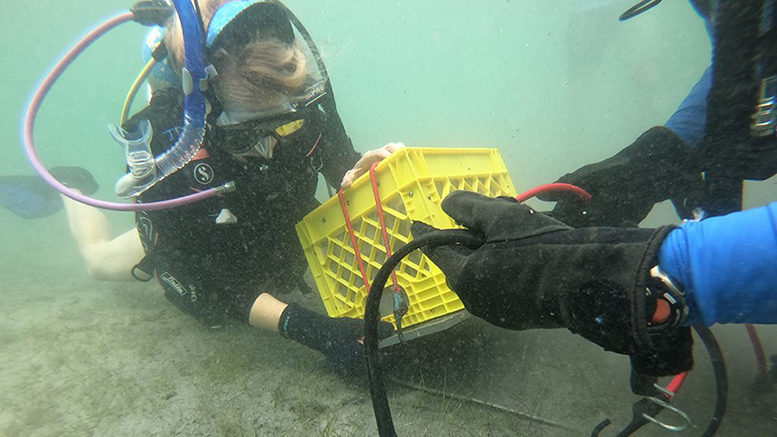About five years ago, Jessica Miles submerged marine life monitoring structures in Florida’s Jupiter Inlet as part of an effort to engage students to save coral reefs. She and her team couldn’t retrieve the units until last month because of the Covid pandemic — but the long wait was worth seeing what an abundance of marine species had made the units home.
Miles, chair of the environmental science department at Palm Beach State College (PBSC), is the driving force behind the college’s participation in the Smithsonian Institution’s National Museum of Natural History Global ARMS Program. ARMS, or autonomous reef monitoring structures, are deployed around the world to help scientists study changes in marine biodiversity and improve ocean health.

Smithsonian scientists were finally able to travel from Washington, D.C., to the Smithsonian Marine Station in Fort Pierce, where they trained Miles and her team in the techniques used to examine the marine life found living in the ARMS. PBSC is the first college in South Florida to participate in the work.
“Palm Beach State College is pioneering the type of partnership that is really important as we build a broader community of people monitoring ocean health,” said Christopher Meyer, a Smithsonian research zoologist and curator of marine invertebrates. “This workshop was a training exercise to share and spread ARMS knowledge, and the best part is having Palm Beach State so close to our marine station and the potential for future growth and engagement.”
The creepy crawly things
ARMS are designed to mimic the nooks and crannies of reef habitats and become dwellings for marine species. Not big fish and turtles, but creepy crawly things like brittle stars, snapping shrimp, crabs, sea urchins and snails to name a few. Built of nine 9” x 9” stacked plates, ARMS are like mini-condos, and upon retrieval, scientists can see what took up residence and learn more about the health and diversity of reef ecosystems and the impacts of ocean stressors like pollution and ocean acidification.
Knowing how marine species respond to different ocean states can help scientists predict and plan actions for a healthier planet, according to the Global ARMS Program website.
“I really see this as groundbreaking for us to understand what a lot of these local organisms are and catalog them so that we’re aware of what’s here,” Miles said. “Then in the future, we can continue to monitor and see if their presence continues or changes. Maybe some of these animals will move further north as the climate changes, seeking out cooler waters. This type of study is the least invasive kind of research project we can do to understand what the complexity of species actually are.”
Working as a team
The ARMS were analyzed over three days by a team that included three Smithsonian scientists, Jupiter Inlet Lighthouse Outstanding Natural Area staff, Miles and other PBSC faculty and students.
“Just imagine having my students sitting right next to these expert Smithsonian scientists. It doesn’t get much better than that,” Miles said.
Palm Beach State’s participation is also important to the Smithsonian Institution.
“We’re very excited to use this as an initial partnership to figure out what motivates people to use the tools and how to maintain enthusiasm as we scale out the ARMS program and get more people to participate, because it takes a village,” Meyer said.

Meyer and Sarah Tweedt, a Smithsonian research associate in invertebrate zoology, conducted the workshop with the support of Dean Janiak, a biologist and one of the resident scientists based at the Smithsonian Marine Station.
“Watching them work was a mind-blowing experience,” said Rida Talukdar, a PBSC student pursuing an associate degree in environmental science technology and Dr. Miles’ student assistant. “The scientists would always make sure to stop and explain what they were doing and if we ever had any questions, they would explain everything to us, teaching us all the processes of disassembling the ARMS and how to study the creatures.”
Poring over the information
Hundreds of species were discovered living in the three ARMS, but thousands more remain to be discovered using DNA metabarcoding techniques over the next several months. Miles will then work toward publishing the findings and hopes to create a public exhibit that can move from nature center to nature center and campus to campus, to share what the team discovered.
“A lot of people experience the ocean, but just on the surface, as a blanket of blue water. They don’t get to see what’s going on underneath,” Miles said. “They don’t get to know these characters that are really sustaining the health and vitality of our coastal ecosystem. We get a chance to do that if we scuba dive, but most people do not get to have that kind of opportunity. So this is a way for us to bring all of that information to light.”
GianAntoni Consalvo, another of Miles’ students, plans a career in wildlife biology that will involve field research like he experienced with the ARMS retrieval and lab analysis.
“This experience was honestly, probably one of the most exciting things that has happened to me in my life so far,” Consalvo said. “Because, I mean, who doesn’t want to go find out what creatures are living inside these little artificial reefs. It gave me a taste of what it’s like to do something like this, and now that I have, it’s like I’m hooked — I don’t want to do anything else.”

